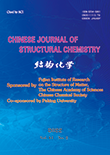Structural and Magnetic Characterization of Two New Coordination Compounds Based on a Fluorene Derivative Ligand
YANG Qing-Feng*, YUE Kai, WANG Zhi-Hui, LAI Xiao-Yong, WANG Xiao-Zhong* and QIN Ling
Chin. J. Struct. Chem. 2022, 41, 2202064-2202072 DOI: 10.14102/j.cnki.0254-5861.2011-3266
February 15, 2022
low-dimensional coordination compounds, fluorene derivative, magnetic properties
ABSTRACT
Two
new coordination compounds [Co(FDC)2(H2O)2]n (1) and [Cu(FDC)2(2,2΄-bpy)]·DMF·H2O (2)
(HFDC = 9-fluorenone-4-carboxylic acid, bpy = 2,2΄-bipyridine,
DMF = N,N-dimethylformamide) were prepared by the reactions of corresponding
metal salts with a fluorene derivative ligand of HFDC. Both compounds were
thoroughly analyzed by X-ray single-crystal diffraction, elemental analysis, IR
spectra, PXRD and thermal analysis. Compound 1 features a 1D structure. Via two kinds of O‒H···O hydrogen bonds, such 1D chains self-assemble into a 3D
supramolecular structure stabilized by the offset face-to-face π···π interactions. Compound 2 features a dinuclear structure which, via O‒H···O
and C‒H···O hydrogen bonds, self-assembles into a 2D supramolecular layer
strengthened by strong face-to-face π···π interactions. And variable-temperature
magnetic susceptibilities of 1 and 2 indicate weak
antiferromagnetic interactions between the Co(II) and Cu(II) metal ions.








